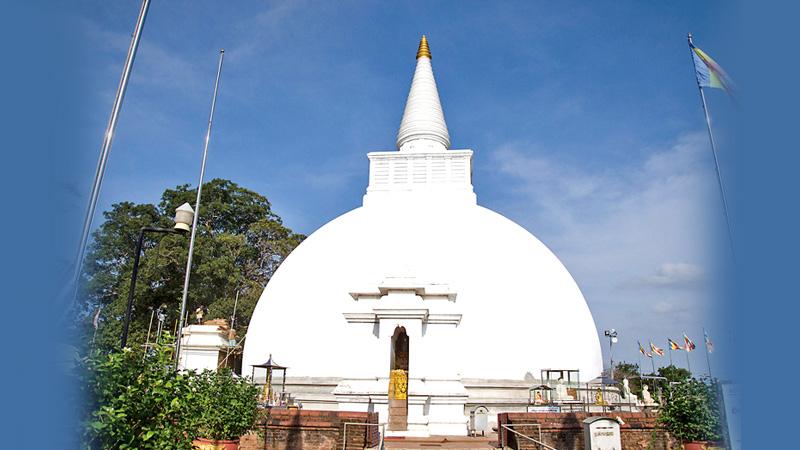
We were on our way to Somawathiya Chaitya. From Medirigiriya, we passed through Sungawila, and took the road that had previously been a bumpy, unpaved track that loosely connected a number of dilapidated bridges. This time around, the road is carpeted and the bridges are new. Traversing this stretch is conveniently smooth. We had aimed to reach Somawathiya early in the day, but got side-tracked by the various sites en-route and arrived late in the morning.
 Known as a place of mysterious sights and miracle rays of light, the Somawathiya Chaitya lies 50 kilometres North-East of Polonnaruwa, in the jungles of the Somawathiya Wildlife Sanctuary. Today, it is deemed as being part of the Wasgamuwa Strict Natural Reserve, the floodplains of the Mahaweli river and the Trikonamadu Natural Reserve.
Known as a place of mysterious sights and miracle rays of light, the Somawathiya Chaitya lies 50 kilometres North-East of Polonnaruwa, in the jungles of the Somawathiya Wildlife Sanctuary. Today, it is deemed as being part of the Wasgamuwa Strict Natural Reserve, the floodplains of the Mahaweli river and the Trikonamadu Natural Reserve.
 The Somawathiya strict natural reserve and wildlife sanctuary is under the purview of the Department of Wildlife Conservation. It is 37,645.5 hectares and was established first as a wildlife sanctuary in 1966 and as a national park in 1986. It is one of the four national parks belonging to the Mahaweli Development Project.
The Somawathiya strict natural reserve and wildlife sanctuary is under the purview of the Department of Wildlife Conservation. It is 37,645.5 hectares and was established first as a wildlife sanctuary in 1966 and as a national park in 1986. It is one of the four national parks belonging to the Mahaweli Development Project.
Marshy land
It is home to a wide variety of animals, the most commonly sighted being elephants. Somawathiya is famous for herds of elephants. This is mainly because the area consists of villu (marshes with water tolerant and aquatic plants) which the elephants love to eat. Other species found here include leopard, jackal, deer, sambar and water buffalo.
Being in the Somawathiya Wildlife Sanctuary, herds of elephants roam the surrounding wilderness of the Somawathiya Chaitya, making it one of the best places to spot herds of elephant. During our stay, we saw herds of elephants grazing in the jungle close to the Chaitya and also a lone elephant standing near the electric fence, perhaps begging for food from pilgrims. However, the Chaitya premises is covered with an electric fence preventing wild elephants entering the sacred area.
It is believed that one Prince Giri Aba who was married to Princess Somawathi, the sister of King Kavantissa of Ruhuna, built the Somawathiya Chaitya in the 2nd Century AD. They lived in and ruled over an area called Somapura which was on the bed of the Mahaweli River. The Somawathiya Chaitya was built upon the request of the princess who wanted a temple to perform religious activities.
The right tooth relic of the Buddha is enshrined in the relic chamber of the Chaitya and is believed to be the one of the two remaining tooth relics in the world, the other being at the Sri Dalada Maligawa in Kandy.
Foreign invasions
The Somawathiya Chaitya was maintained by several kings who succeeded Prince Aba, but it was later abandoned during foreign invasions. It was again discovered in the 1940’s. Archaeologists began excavations in the site in 1964. They unearthed many ruins including stone inscriptions, moonstones and flower pedestals.

In 1987, the Somawathiya area came under terrorist attacks. A massacre was carried out in a nearby village. The caretaker of the temple was also killed in the attack. The bhikkhus and civilians who resided in the area fled for safety after the nearby Seruwila Raja Maha Vihara was attacked by the LTTE resulting in fatalities.
The area was largely abandoned for the next 15 years until the temple was renovated in 2002 during a ceasefire with the LTTE and reopened to the public. Now, it is regularly visited by pilgrims and has become a tourist attraction as well.
Historical records state that the Somawathiya Chaitya was on the Eastern bank of the Mahaweli river. However, it is now close to the West bank of the river. There was speculation as to whether this was the same temple referred to in ancient chronicles. This was later resolved when it was discovered that as the years went by, the river had gradually changed its course. It is believed that the road that leads to the temple was the original course of the river.
Eric Swan rock
The Eric Swan rock is close to the entrance to the temple. It is so named because a person called Eric Swan, a photographer who shot at the reclining Buddha statue carved into a rock was killed on that rock by a wild elephant who was agitated by the sound of the gunshot.
We didn’t get to see the rock, but heard the story from a caretaker at the temple.
It has been alleged on several occasions that beams of light (Budu Res or Buddha rays) radiated out of the Chaitya, the most recent being during a former President’s visit to Somawathiya Chaitya in January, 2012.
This kind of phenomena was first reported in 1977 and then in 1981, 2002 and 2006. While there are eyewitnesses and photographs of this, it remains an unexplained phenomenon.
Whether you’re a believer or a non-believer of such phenomena, Somawathiya is an area worth visiting if you’re a history and archaeology buff or a wildlife enthusiast or both, like us. If you visit early in the morning, you can have the added bonus of watching the sun rise over the Chaitya.
